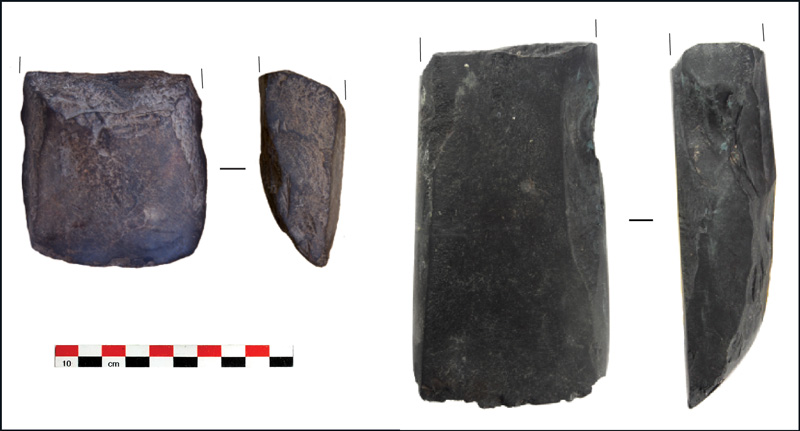Long before Europeans set foot in the South Pacific, seafaring people from Oceania and Southeast Asia had settled the islands of Melanesia, Micronesia, and Polynesia, using star and wind compasses and large canoes to traverse the ocean. In a recent study, scientists traced these migrations by analyzing the chemistry of stone tools.
Researchers collected data from tools found in the Polynesian Outliers, a group of islands scattered between New Guinea and Fiji that includes the Solomon Islands, the Caroline Islands, and Vanuatu. Measuring the stones’ chemical compositions made it possible to match them with their source regions, demonstrating that people transported tools far from their origins.
Fingerprinting the Stone
Researchers examined ancient artifacts such as adzes (cutting tools similar to axes) made from volcanic stones. To determine where the stones came from, the scientists relied on the fact that different volcanoes produce magmas with distinct chemical features.
Some volcanoes form at subduction boundaries, where one tectonic plate descends underneath another, as in Japan or the Cascades of northwestern America. Other volcanoes develop in the middle of tectonic plates—at hot spots that lift buoyant material through Earth’s mantle.
Many South Pacific islands, including those of Fiji, Hawaii, and Samoa, were formed by hot spot volcanism; the archipelagoes that make up the Solomon Islands and Vanuatu, however, are located at a subduction zone.
Each volcano produces lava with a characteristic chemical fingerprint.
Because hot spot lavas come from the base of the lithosphere, their chemical composition is similar to the mantle’s, whereas subduction-related lavas are more strongly influenced by the thicker crust the melt passes through. The chemistry of a volcanic stone tells scientists what kind of setting it formed in, helping them home in on its source.
Furthermore, each volcano produces lava with a characteristic chemical fingerprint. For that reason, “analyzing the geochemistry of stone artifacts is an often unambiguous method for tracking where people originally quarried the stone,” explained Peter Mills, an anthropologist at the University of Hawai‘i at Hilo who was not involved with the new research.
The researchers used Pofatu and GEOROC (Geochemistry of Rocks of the Oceans and Continents), repositories of published geochemical data, to compare their measurements with existing records from the Pacific islands. They then matched the artifacts with their source regions—like matching a suspect’s fingerprint in a database.
Samoan Stones Traveled Thousands of Kilometers
According to the group’s results, ancient people made many long-distance voyages between the 13th and 18th centuries. Adzes carved from stone from a Samoan quarry were found on the islands of Taumako, Solomon Islands, and Emae, Vanuatu, almost 2,500 kilometers (1,550 miles) west of Samoa and 800 kilometers (500 miles) apart.

Because the islands were probably settled by eastward migration from Oceania and Southeast Asia, Mills said, “it is especially exciting to find clear evidence of stone tools made in Samoa traveling 2,500 kilometers westward, back in the direction of ancestral homelands.”
Early people also imported stones that couldn’t be found close to home. Obsidian from northern Vanuatu was found on Emae, 360 kilometers (220 miles) to the south. Obsidian—a hard volcanic glass that breaks into sharp-edged flakes—was fashioned into blades and cutting tools. Vanuatu obsidian has been found on other Polynesian Outliers, implying the islands’ inhabitants likely traded or transported valuable items.
Aymeric Hermann, an archaeologist at the French National Centre for Scientific Research (CNRS) and lead author of the new study, noted that the results contributed to an ongoing shift in our understanding of Polynesian history. “The Polynesian Outliers were historically considered as cultural isolates,” he said. But the geochemical studies suggested that ancient peoples maintained contact with other islands after the archipelagoes were settled.
“One doesn’t sample objects of historical and cultural value like one would sample a natural rock.”
Using geochemistry to trace ancient migrations has several advantages: It produces hard evidence that can corroborate or flesh out oral histories and avoids ethical issues implicit in other ethnographic methods, such as collecting human DNA. But, Mills said, researchers should be aware that stone artifacts have cultural meaning. “Any destructive analysis of stone tools should involve discussions with descendant communities,” he said.
Hermann agreed that being sensitive to local communities’ heritage is essential. “One doesn’t sample objects of historical and cultural value like one would sample a natural rock,” he said. Hermann and his coauthors drilled 3-millimeter-diameter (~0.1-inch) holes into the artifacts to extract material for chemical analysis. The sampling was conducted through a research agreement with the Cultural Council of the Vanuatu Cultural Centre.
Edson Willie, a member of the Vanuatu Cultural Centre and a coauthor of the study, said nondestructive methods are preferable, but in this case the benefit of learning about the artifacts outweighed the drawbacks of destructive sampling.
“Conducting research on artifacts is important, as it sheds light on our cultures and traditions,” he said. Willie explained that oral histories link Vanuatu to other Pacific islands. By tracing stone artifacts’ origins, “the research reinforces these linkages and confirms stories told around the fireplace at night by our elders.”
—Caroline Hasler (@carbonbasedcary), Science Writer

